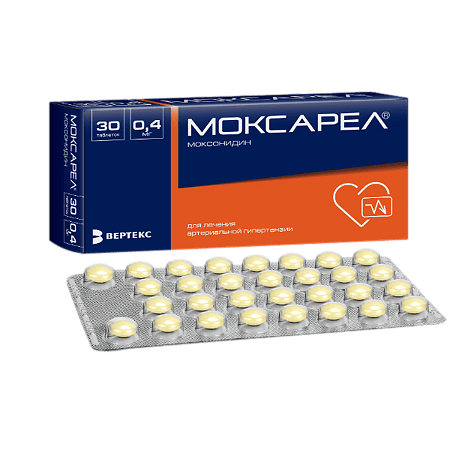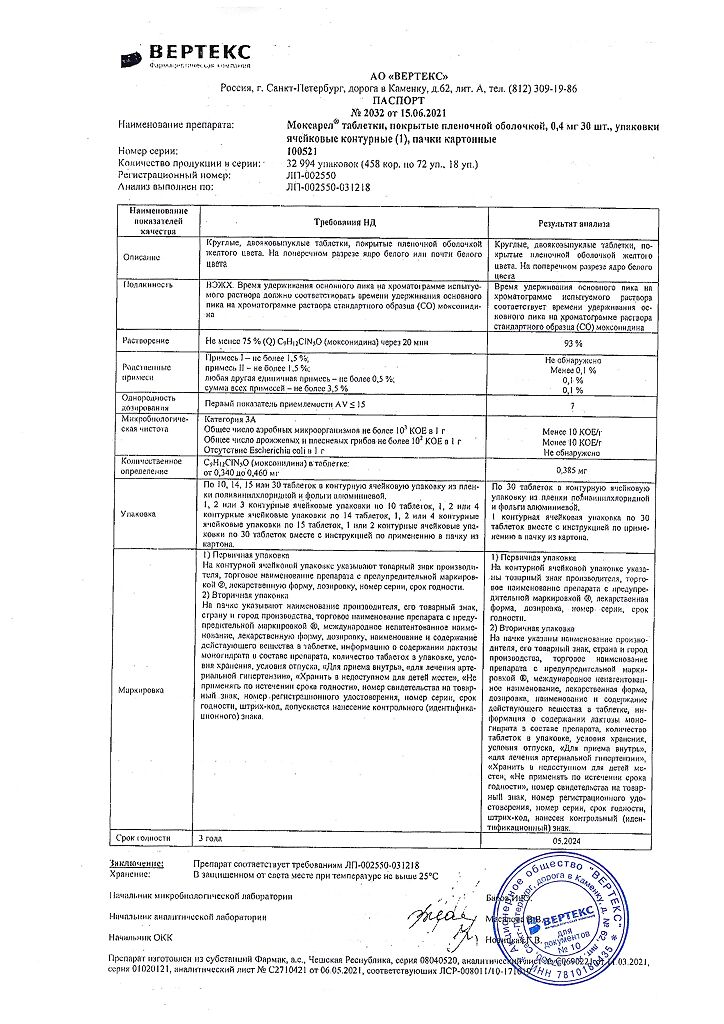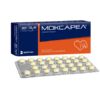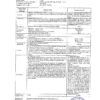No products in the cart.
Moxarel, 0.4 mg 30 pcs
€12.65 €11.07
Description
Pharmacotherapeutic group
Hypotensive agent of central action.
Code ATX: C02AC05
Pharmacological properties
Pharmacodynamics
Moxonidine is a hypotensive agent, the action of which is associated with the effect on the central mechanisms of regulation of sympathetic nervous system activity and blood pressure. In brain stem structures (rostral layer of lateral ventricles) moxonidine selectively stimulates imidazolin-sensitive receptors that participate in tonic and reflex regulation of sympathetic nervous system. Stimulation of imidazoline receptors reduces peripheral sympathetic activity and blood pressure (BP).
Moxonidine differs from other sympatholytic hypotensive agents in its lower affinity for α2-adrenoreceptors, which explains the lower probability of developing sedation and dry mouth when using it.
The administration of moxonidine is accompanied by a decrease in systemic vascular resistance and BP. The hypotensive effect of moxonidine has been confirmed in double-blind placebo controlled randomized trials.
. Results from a clinical trial involving 42 patients with arterial hypertension and left ventricular hypertrophy (LVH) demonstrated that with similar blood pressure reductions, use of a combination of angiotensin II receptor antagonists with moxonidine reduces LVH to a greater extent than the combination of a thiazide diuretic and a calcium channel blocker (15% versus 11%; p < 0.5).
Moxonidine improves insulin sensitivity index by 21% (compared with placebo) in patients with obesity, insulin resistance, and moderate arterial hypertension.
Pharmacokinetics
absorption
After oral administration, moxonidine is rapidly and almost completely absorbed in the upper gastrointestinal tract. Absolute bioavailability is approximately 88%, indicating no significant “first pass” effect. Time of reaching maximum concentration is about 1 hour. Food intake has no effect on the pharmacokinetics of the drug.
Distribution
The binding to plasma proteins is 7.2%.
Metabolism
The main metabolite is a dehydrated moxonidine derivative. The pharmacodynamic activity of the main metabolite is about 10% of the activity of moxonidine.
Elimation
The elimination half-life (T1/2) of moxonidine and the dehydrated metabolite is 2.5 and 5 hours, respectively. Within 24 hours more than 90% of moxonidine is excreted by the kidneys (about 78% unchanged and 13% as dehydromoxonidine, the level of other metabolites in the urine does not exceed 8% of the dose taken). Less than 1% of the dose is excreted through the intestine.
Pharmacokinetics in special patient groups
Patients with arterial hypertension
In comparison with healthy volunteers, patients with arterial hypertension show no changes in the pharmacokinetics of moxonidine.
Elderly patients
Clinically insignificant changes in moxonidine pharmacokinetic parameters have been observed in elderly patients, probably due to decreased metabolic rate and/or slightly higher bioavailability.
Children
Moxonidine is contraindicated for use in patients younger than 18 years, and therefore no pharmacokinetic studies have been performed in this group.
Patients with renal impairment
The excretion of moxonidine is highly correlated with creatinine clearance (CK). In patients with moderate renal impairment (CK between
30-60 ml/min), equilibrium plasma concentrations and final T1/2 are approximately 2 and 1.5 times higher than in patients with normal renal function (CK greater than 90 ml/min).
In patients with severe renal impairment (CKI less than 30 mL/min), equilibrium plasma concentrations and final T1/2 are 3 times higher than in patients with normal renal function. Administration of multiple doses of moxonidine results in predictable cumulation in patients with moderate to severe renal impairment. In patients with terminal renal failure (CKR less than 10 mL/min) on hemodialysis, equilibrium plasma concentrations and final T1/2 are 6 and 4 times higher, respectively, than in patients with normal renal function. In patients with moderate renal impairment, the maximum plasma concentration of moxonidine is 1.5-2 times higher. In patients with impaired renal function the dosage should be adjusted individually.
Moxonidine is slightly excreted during hemodialysis.
Indications
Indications
Arterial hypertension.
Pharmacological effect
Pharmacological effect
Pharmacotherapeutic group
Centrally acting antihypertensive agent.
ATX code: C02AC05
Pharmacological properties
Pharmacodynamics
Moxonidine is an antihypertensive drug, the action of which is associated with an effect on the central mechanisms regulating the activity of the sympathetic nervous system and blood pressure. In the stem structures of the brain (rostral layer of the lateral ventricles), moxonidine selectively stimulates imidazoline-sensitive receptors that take part in the tonic and reflex regulation of the sympathetic nervous system. Stimulation of imidazoline receptors reduces peripheral sympathetic activity and blood pressure (BP).
Moxonidine differs from other sympatholytic antihypertensive drugs in its lower affinity for α2-adrenergic receptors, which explains the lower likelihood of developing sedation and dry mouth when used.
Taking moxonidine is accompanied by a decrease in systemic vascular resistance and blood pressure. The hypotensive effect of moxonidine has been confirmed in double-blind, placebo-controlled, randomized studies.
The results of a clinical trial involving 42 patients with arterial hypertension and left ventricular hypertrophy (LVH) demonstrated that, with a similar reduction in blood pressure, the use of a combination of angiotensin II receptor antagonists with moxonidine reduced LVH to a greater extent compared with the combination of a thiazide diuretic and a calcium channel blocker (15% versus 11%; p < 0.5).
Moxonidine improves the insulin sensitivity index by 21% (compared to placebo) in patients with obesity, insulin resistance and moderate hypertension.
Pharmacokinetics
Suction
After oral administration, moxonidine is rapidly and almost completely absorbed from the upper gastrointestinal tract. Absolute bioavailability is approximately 88%, indicating no significant first-pass effect. The time to reach maximum concentration is about 1 hour. Food intake does not affect the pharmacokinetics of the drug.
Distribution
The connection with blood plasma proteins is 7.2%.
Metabolism
The main metabolite is a dehydrogenated derivative of moxonidine. The pharmacodynamic activity of the main metabolite is about 10% of the activity of moxonidine.
Removal
The half-life (T1/2) of moxonidine and the dehydrogenated metabolite is 2.5 and 5 hours, respectively. Within 24 hours, over 90% of moxonidine is excreted by the kidneys (about 78% unchanged and 13% as dehydromoxonidine, the level of other metabolites in the urine does not exceed 8% of the dose taken). Less than 1% of the dose is excreted through the intestines.
Pharmacokinetics in special groups of patients
Patients with arterial hypertension
Compared with healthy volunteers, patients with arterial hypertension show no changes in the pharmacokinetics of moxonidine.
Elderly patients
Clinically insignificant changes in the pharmacokinetic parameters of moxonidine were noted in elderly patients, probably due to a decrease in the intensity of its metabolism and/or slightly higher bioavailability.
Children
Moxonidine is contraindicated for use in patients under 18 years of age, and therefore pharmacokinetic studies have not been conducted in this group.
Patients with renal failure
Moxonidine excretion is significantly correlated with creatinine clearance (CC). In patients with moderate renal failure (creatinine clearance in the range
30-60 ml/min) equilibrium concentrations in blood plasma and final T1/2 are approximately 2 and 1.5 times higher than in patients with normal renal function (creatinine clearance more than 90 ml/min).
In patients with severe renal failure (creatinine clearance less than 30 ml/min), steady-state plasma concentrations and final T1/2 are 3 times higher than in patients with normal renal function. The administration of multiple doses of moxonidine leads to predictable accumulation in the body of patients with moderate and severe renal failure. In patients with end-stage renal failure (creatinine clearance less than 10 ml/min) on hemodialysis, steady-state plasma concentrations and final T1/2 are 6 and 4 times higher, respectively, than in patients with normal renal function. In patients with moderate renal failure, the maximum concentration of moxonidine in the blood plasma is 1.5-2 times higher. In patients with impaired renal function, the dosage should be adjusted individually.
Moxonidine is excreted to a small extent during hemodialysis.
Special instructions
Special instructions
During treatment, regular blood pressure monitoring is necessary.
Post-marketing surveillance has documented cases of atrioventricular block of varying severity in patients taking moxonidine. A connection between taking Moxarel® and slowing of atrioventricular conduction cannot be completely excluded. Therefore, caution is recommended when treating patients with a possible predisposition to developing atrioventricular block.
There is currently no evidence that stopping Moxarel® leads to an increase in blood pressure. However, it is not recommended to stop taking Moxarel® suddenly; instead, you should gradually reduce the dose of the drug over two weeks.
If it is necessary to cancel concomitantly taken beta-blockers and the drug Moxarel®, first cancel the beta-blockers and only after a few days moxonidine.
Elderly patients may have an increased risk of developing cardiovascular complications due to the use of antihypertensive drugs, therefore therapy with Moxarel® should be started with a minimum dose.
During treatment, regular monitoring of blood pressure, heart rate and electrocardiography (ECG) registration is necessary. You should stop taking Moxarel® gradually.
Alcohol consumption should be avoided during treatment with Moxarel®.
Influence on the ability to drive vehicles and machinery
The effect of Moxarel® on the ability to drive vehicles and operate machinery has not been studied. However, given the possible occurrence of dizziness and drowsiness, patients should exercise caution when engaging in potentially hazardous activities that require increased alertness.
Active ingredient
Active ingredient
Moxonidine
Composition
Composition
active ingredient: moxonidine – 0.40 mg;
excipients: lactose monohydrate – 64.00 mg, microcrystalline cellulose 101 – 14.80 mg, microcrystalline cellulose 102 – 14.80 mg, povidone K-30 – 2.00 mg, croscarmellose sodium – 2.00 mg, colloidal silicon dioxide – 1.00 mg, magnesium stearate – 1.00 mg.
Film coating: [hypromellose – 1.80 mg, talc – 0.60 mg, titanium dioxide – 0.31 mg, macrogol 4000 (polyethylene glycol 4000) – 0.27 mg, iron oxide yellow – 0.02 mg] or [dry film coating mixture containing hypromellose (60%), talc (20%), titanium dioxide (10.33%), macrogol 4000 (polyethylene glycol 4000) (9%), iron oxide yellow dye (0.67%)] – 3.00 mg.
Pregnancy
Pregnancy
Pregnancy
There are no clinical data on the treatment of pregnant women with Moxarel®.
In a study on animals, the embryotoxic effect of the drug was established at dosages above therapeutic ones. The potential risk to humans is unknown.
Pregnant women should prescribe Moxarel® with caution only after a careful assessment by the doctor of the risk-benefit ratio, when the benefit to the mother outweighs the potential risk to the fetus.
Breastfeeding period
Moxonidine passes into breast milk and therefore should not be administered during breastfeeding. If it is necessary to use the drug, breastfeeding should be stopped.
Contraindications
Contraindications
hypersensitivity to moxonidine and other components of the drug;
history of angioedema;
sick sinus syndrome or sinoatrial block;
severe liver failure;
atrioventricular block II and III degrees;
severe bradycardia (resting heart rate (HR) less than 50 beats/min);
acute and chronic heart failure (III-IV functional class according to the NYHA classification);
severe renal failure;
age under 18 years (the effectiveness and safety of moxonidine have not been established);
breastfeeding period;
hereditary galactose intolerance, lactase deficiency, glucose-galactose malabsorption.
With caution
atrioventricular block of the first degree (risk of developing bradycardia);
diseases of the coronary arteries (including coronary heart disease, unstable angina, early post-infarction period);
diseases of peripheral circulation (including intermittent claudication, Raynaud’s syndrome);
epilepsy;
Parkinson’s disease;
depression;
glaucoma;
moderate renal failure (creatinine clearance 30-60 ml/min, serum creatinine
105-160 µmol/l);
liver failure;
pregnancy.
Side Effects
Side Effects
The most common side effects in patients taking moxonidine: dry mouth, dizziness, asthenia, drowsiness. These symptoms usually decrease after the first weeks of therapy.
Classification of the incidence of side effects according to the recommendations of the World Health Organization (WHO):
very often ≥ 1/10;
often from ≥ 1/100 to < 1/10;
infrequently from ≥ 1/1000 to < 1/100;
rarely from ≥ 1/10000 to < 1/1000;
very rarely <1/10000, including isolated reports;
frequency unknown – based on available data, it is not possible to determine the frequency of occurrence.
Nervous system disorders:
often – headache*, dizziness (vertigo), drowsiness, insomnia;
infrequently – fainting*, increased excitability.
Cardiac disorders:
infrequently – bradycardia.
Vascular disorders:
uncommon – marked decrease in blood pressure, orthostatic hypotension.
Disorders of the hearing organ and labyrinth:
infrequently – ringing in the ears.
Gastrointestinal disorders:
very often – dry mouth;
often – nausea, diarrhea, vomiting, dyspepsia.
Skin and subcutaneous tissue disorders:
often – skin rash, itching;
infrequently – angioedema.
Muscle, skeletal and connective tissue disorders:
often – back pain;
infrequently – pain in the neck.
General disorders and reactions at the injection site:
often – asthenia;
infrequently – peripheral edema.
*frequency comparable to placebo
Interaction
Interaction
The combined use of moxonidine with other antihypertensive drugs leads to an additive effect.
Tricyclic antidepressants may reduce the effectiveness of centrally acting antihypertensive drugs, and therefore their use together with moxonidine is not recommended.
Moxonidine may enhance the sedative effect of tricyclic antidepressants (co-administration should be avoided), tranquilizers, ethanol, sedatives and hypnotics.
Moxonidine may moderately improve impaired cognitive function in patients receiving lorazepam. Prescribing moxonidine together with benzodiazepine derivatives may be accompanied by an increase in the sedative effect of the latter.
Moxonidine is released by tubular secretion, so its interaction with other drugs released by tubular secretion is possible.
Overdose
Overdose
Several cases of non-fatal overdose have been reported when doses up to 19.6 mg were used concomitantly.
Symptoms
Headache, sedation, drowsiness, marked decrease in blood pressure, dizziness, fatigue, asthenia, bradycardia, dry mouth, vomiting and pain in the epigastric region, respiratory depression, impaired consciousness. In addition, short-term increases in blood pressure, tachycardia, and hyperglycemia are possible, as has been shown in several studies of high doses of the drug in animals.
Treatment
There is no specific antidote. In case of a pronounced decrease in blood pressure, it is recommended to administer fluid to restore circulating blood volume and dopamine (by injection). Bradycardia can be stopped with atropine (injection). Alpha-adrenergic antagonists may reduce or eliminate the paradoxical hypertensive effects of moxonidine overdose.
In severe cases of overdose, it is recommended to carefully monitor disturbances of consciousness and avoid respiratory depression.
Storage conditions
Storage conditions
At a temperature not higher than 25 С.
Keep out of the reach of children.
Shelf life
Shelf life
3 years.
Do not use after expiration date.
Manufacturer
Manufacturer
Vertex, Russia
Additional information
| Shelf life | 3 years. Do not use after the expiration date. |
|---|---|
| Conditions of storage | At a temperature not higher than 25 ° C. Keep out of reach of children. |
| Manufacturer | Vertex, Russia |
| Medication form | pills |
| Brand | Vertex |
Related products
Buy Moxarel, 0.4 mg 30 pcs with delivery to USA, UK, Europe and over 120 other countries.



















